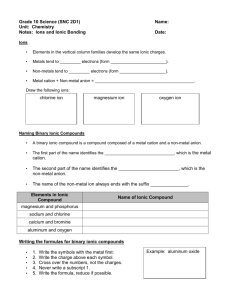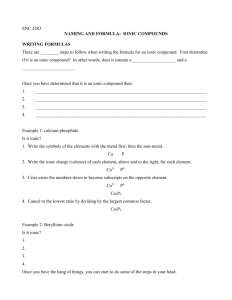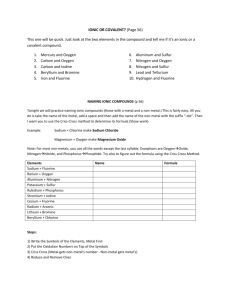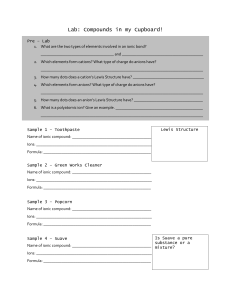Ionic Compound
advertisement
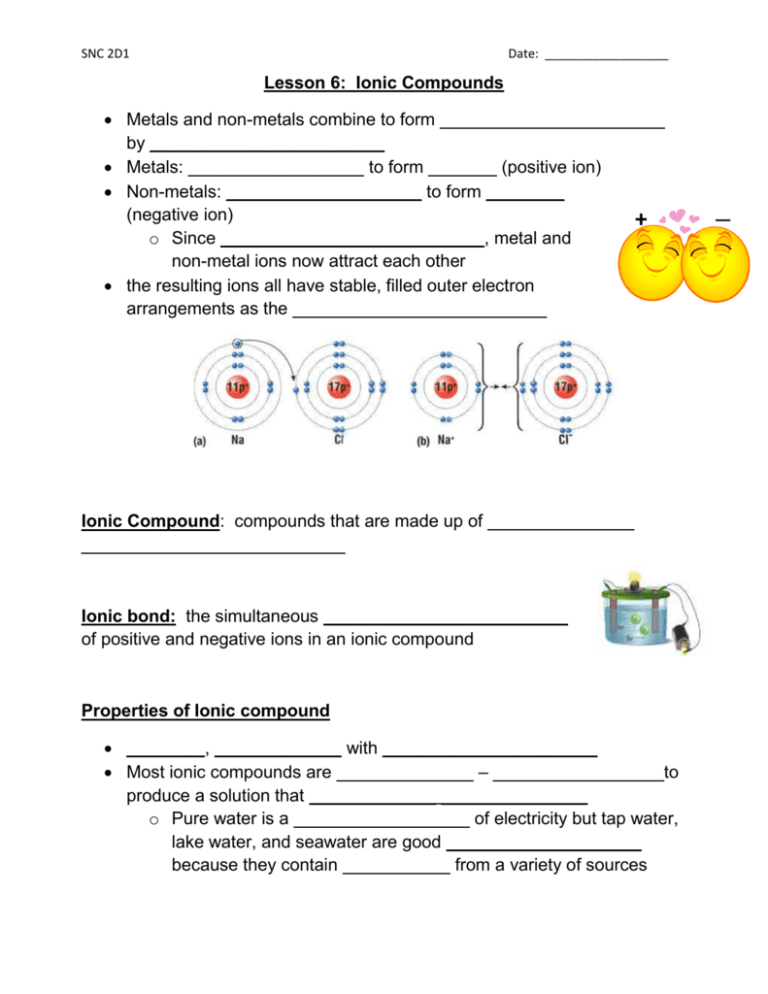
SNC 2D1 Date: __________________ Lesson 6: Ionic Compounds Metals and non-metals combine to form _______________________ by ________________________ Metals: __________________ to form _______ (positive ion) Non-metals: ____________________ to form ________ (negative ion) + o Since ___________________________, metal and non-metal ions now attract each other the resulting ions all have stable, filled outer electron arrangements as the __________________________ Ionic Compound: compounds that are made up of _______________ ___________________________ Ionic bond: the simultaneous _________________________ of positive and negative ions in an ionic compound Properties of Ionic compound ________, _____________ with ______________________ Most ionic compounds are ______________ – _______ __________to produce a solution that _____________ _______________ o Pure water is a __________________ of electricity but tap water, lake water, and seawater are good ____________________ because they contain ___________ from a variety of sources ─ SNC 2D1 Date: __________________ Naming Ionic Compounds: The ____________________________________ in the compound and the _____________________________________ Metal ion: name remains the __________ Non-metal ion: ending changes to _____________ e.g. _________________ Chemical Formulas: In a compound, the number of _______________________ must _________ the total number of _______________________ e.g. Magnesium and Chlorine Step1: Write the symbol of the elements. Metal on the left, non-metal on the right Step 2: Add ionic charge of each ion above the symbol Step 3: Crisscross Rule: Crisscross the numbers of the ionic charges so that they now become subscripts for the opposite elements Step 4: State the chemical formula and chemical name Special Rules: Do not write the subscript “1” Reduce subscript if there is a common factor SNC 2D1 Date: __________________ e.g. Aluminum and oxygen e.g. Magnesium and Sulfur Element with Multiple Ionic Charges Some metals have two stable cations The Roman numerals in rounded brackets are used to indicate the ionic charge of the metal Metal Chemical symbol of element Copper Cu Iron Fe Lead Pb Mangenese Mn Tin Sn e.g. Copper (II) Nitride Chemical symbols of ions Cu+ Cu2+ Fe2+ Fe3+ Pb2+ Pb4+ Mn2+ Mn4+ Sn2+ Sn4+ Names of ions Copper (I) Copper (II) Iron (II) Iron (III) Lead (II) Lead (IV) Manganese (II) Manganese (IV) Tin (II) Tin (IV) SNC 2D1 Date: __________________ e.g. Determine the chemical name of PbO2 Step one: Reverse crisscross Step two: Check the charge of the anion. If it has reduced, multiply the cation and anion’s charges by the reduced factor e.g. CuBr2 Read Section 5.6; answer questions # 1, 2, 3 on page 195. Read Section 5.7; answer questions # 2, 3, 4, 7 on page 200.
